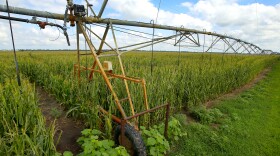National farm income will likely reach highs not seen since 1973, according to estimates from the U.S. Department of Agriculture.
That’s despite a challenging season that stacked drought, bird flu and costly fertilizer and fuel against farmers and ranchers.
Or perhaps income is high not in spite but because of the difficult season, said American Farm Bureau Federation economist Bernt Nelson.
“This year really came with a lot of obstacles; we saw a lot of things like inflation and increased farm production expenses,” he said. “As these prices have risen, they’ve really risen because of the obstacles.”
Dryness and disease tightened food supplies, pushing up prices. Grain markets skyrocketed when Russia invaded Ukraine and curbed wheat exports.
The USDA expects national net farm income to increase about 14% from last year to $160.5 billion dollars. On the whole, farmers and ranchers may receive the most cash for selling their goods since the department started its accounting in 1929.
Those numbers are tentative. The USDA will revise estimates before issuing a final report on 2022 incomes in the new year.
Not across the board
Agricultural economist Brad Lubben — who works on policy at the University of Nebraska-Lincoln’s Center for Agricultural Profitability — said those gains aren’t across the board.
“The drought definitely hurt the Midwest and the Great Plains much more than it did the rest of the country,” he said. “And in some of those places, higher prices don't make up for the lost bushels.”
For example, Lubben’s research has indicated 2022 farm income would be nearly flat in Nebraska.
The earnings are also typically strongest in the largest farm operations, according to Lubben, which work at massive scale and produce most of the nation’s food.
“That’s not every farm,” he said. “That’s not even a majority of farms. It’s concentrated in larger operations.”
Smaller, diversified farms that sell small grains like barley and rye or vegetables haven’t seen the same growth in demand and prices for their products that commodity farmers have.
Cait Caughey is a farmer and works with local growers at the Center for Rural Affairs. She said the hurdles for small producers are significant.
“Inflation and supply shortages have affected business,” she said. “It’s everything from feed to fertilizer to meat processing, to whatever you need to produce food. Those prices have been increasing for years.”
Caughey said farmers are examining their costs and contemplating rising prices at next year’s farmers markets or in selling crop sharing subscriptions.
After all, the price tags for farming inputs like animal feed, fertilizer and fuel have risen even faster than income. The USDA notes costs are expected to see the highest year-over-year increase ever, with nearly every category of expense going up in 2022.
Looking forward
Even in a time of high incomes, farm groups argue that the government needs to do more to support agriculture.
They point to the margin of profitability — prices are high, but so are inputs. They say farmers and ranchers can’t always count on exorbitant prices to balance out expenses.
“Just because we’ve had these high prices doesn’t mean everyone is profiting equally,” Nelson said. “Nor does it mean that profits will remain positive going through next year as we face things like inflation and a potentially continuing drought.”
The debate will be especially prominent in the upcoming year as Congress debates the terms of the new Farm Bill. Farm groups are pushing to raise reference prices for crop insurance programs, which they say don’t factor in high expenses.
“There’s an awful lot of downside risk before the existing safety net really kicks in,” Lubben said. “So there’s not much safety in the current safety net, so to speak.”
This story was produced in partnership with Harvest Public Media, a collaboration of public media newsrooms in the Midwest. It reports on food systems, agriculture and rural issues. Follow Harvest on Twitter: @HarvestPM.
Copyright 2023 KCUR 89.3. To see more, visit KCUR 89.3. 9(MDA4OTAxNzAzMDEzMjc0MTc2MzA5ZDZlMw004))







